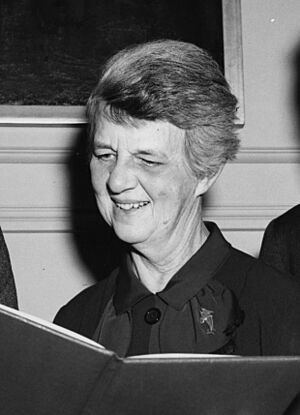Rebecca Lancefield facts for kids
Quick facts for kids
Rebecca Craighill Lancefield
|
|
|---|---|

Lancefield in 1960
|
|
| Born | January 5, 1895 |
| Died | March 3, 1981 (aged 86) |
| Nationality | American |
| Alma mater |
|
| Known for | Lancefield grouping |
| Spouse(s) | Donald Lancefield |
| Awards |
|
| Scientific career | |
| Fields | |
| Institutions |
|
| Doctoral advisor | Hans Zinsser |
| Other academic advisors |
|
Rebecca Craighill Lancefield (born January 5, 1895 – died March 3, 1981) was an important American microbiologist. A microbiologist studies very tiny living things, like bacteria. She started working at the Rockefeller Institute for Medical Research in New York in 1918. She stayed there for her entire amazing career. She wrote over 50 scientific papers during more than 60 years.
Lancefield is most famous for her way of classifying certain bacteria. This method is called Lancefield grouping. It helps scientists sort out different types of Streptococcus bacteria. She looked at special sugars on the outside of the bacteria's cell wall. She also helped classify Group A Streptococci, which are bacteria that can cause illnesses.
Contents
Becoming a Scientist: Early Life and Education
Rebecca Lancefield was born in Fort Wadsworth, Staten Island, New York. Her father was an officer in the US Army. She went to Wellesley College in Massachusetts. In 1916, she earned a degree in zoology, which is the study of animals.
After college, she taught math and science for a year. Then, she received a scholarship to Columbia University. There, she continued to study bacteriology, the study of bacteria. She earned her master's degree from Columbia in 1918. That same year, she married Donald E. Lancefield, who was also a student at Columbia. After graduating, she worked as a technician for Oswald Avery and Alphonse Dochez at Rockefeller.
Discovering Bacteria Secrets: Career and Research
Rebecca Lancefield's first scientific paper was published in 1919. This was unusual for a technician at that time. Before her work, scientists didn't know if different types of streptococci were truly different. Working with Avery and Dochez, she found four main types. These types helped classify 70 percent of the streptococci they studied.
For her PhD, Lancefield studied a type of bacteria called viridans streptococci. She worked mostly at Rockefeller. At the time, people wrongly thought these bacteria caused rheumatic fever. Her research helped show that this idea was incorrect.
How Lancefield Grouping Works
After getting her PhD, Lancefield went back to studying streptococci at Rockefeller. She wanted to find out what parts of the bacteria caused different reactions. In 1928, she found that a special protein on the bacteria's surface was important. She called this the M-protein.
She also discovered that a type of sugar, called C-carbohydrate, was important for grouping bacteria. She realized this sugar was not unique to just one type of bacteria. This discovery led her to create her famous classification system, Lancefield grouping. She first used Group A for human infections and Group B for cow infections. Today, Lancefield groups include groups A through M.
Later, Lancefield found two more proteins on Group A streptococci. She also studied Group B streptococci. She learned that these bacteria didn't have the M-protein. Instead, other sugars on their surface made them harmful.
During World War II, Lancefield helped the military study diseases. In 1946, she became an associate member at Rockefeller University. She became a full professor there in 1958. She worked closely with other important scientists, like Maclyn McCarty.
Awards and Recognition
Rebecca Lancefield was a leader in her field.
- In 1943, she was the second woman to become president of the Society of American Bacteriologists.
- In 1961, she became the first woman president of the American Association of Immunologists.
- She was chosen to join the National Academy of Sciences in 1970. This is a very high honor for scientists.
- In 1973, Rockefeller University gave her an honorary Doctor of Science degree.
- She received many awards, including the T. Duckett Jones Award and the Medal of the New York Academy of Medicine.
Her Lasting Impact
Rebecca Lancefield's lab at Rockefeller was known as "the Scotland Yard of streptococcal mysteries." This was because she was always ready to help solve tough questions about bacteria.
A major scientific meeting, the Lancefield International Symposium, is named after her. The bacteria samples she collected are still kept at Rockefeller University. This collection has over 6,000 different types of streptococci. Her work continues to help scientists understand and fight bacterial diseases.

